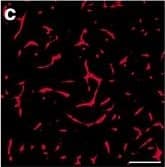Human PlGF Antibody Best Seller
R&D Systems, part of Bio-Techne | Catalog # MAB264


Key Product Details
Validated by
Species Reactivity
Validated:
Cited:
Applications
Validated:
Cited:
Label
Antibody Source
Product Specifications
Immunogen
Ala21-Arg149
Accession # P49763
Specificity
Clonality
Host
Isotype
Scientific Data Images for Human PlGF Antibody
Detection of Human PLGF by Block/Neutralize
Anti-PlGF neutralising antibody blocks DMOG-induced inhibition of ECFC tube formation. ECFCs were stained with calcein (Invitrogen) and grown on Matrigel®. Cells were treated with conditioned medium harvested from ECFCs treated with a DMSO (vehicle) plus isotype control IgG, b DMOG plus isotype control IgG, c DMSO plus anti-PlGF neutralising antibody or d DMOG plus anti-PlGF neutralising antibody. e At 48 h, total tube area (μm2) was quantified using NIS Elements software (Nikon). Data plotted as mean ± SD and are representative of three independent experiments. **p < 0.01; ***p < 0.001. Scale bars: 200 μm (n = 3). DMOG dimethyloxalylglycine, PlGF placental growth factor Image collected and cropped by CiteAb from the following publication (https://pubmed.ncbi.nlm.nih.gov/27899144), licensed under a CC-BY license. Not internally tested by R&D Systems.Detection of Human PLGF by Block/Neutralize
Anti-PlGF neutralising antibody blocks DMOG-induced inhibition of ECFC tube formation. ECFCs were stained with calcein (Invitrogen) and grown on Matrigel®. Cells were treated with conditioned medium harvested from ECFCs treated with a DMSO (vehicle) plus isotype control IgG, b DMOG plus isotype control IgG, c DMSO plus anti-PlGF neutralising antibody or d DMOG plus anti-PlGF neutralising antibody. e At 48 h, total tube area (μm2) was quantified using NIS Elements software (Nikon). Data plotted as mean ± SD and are representative of three independent experiments. **p < 0.01; ***p < 0.001. Scale bars: 200 μm (n = 3). DMOG dimethyloxalylglycine, PlGF placental growth factor Image collected and cropped by CiteAb from the following publication (https://pubmed.ncbi.nlm.nih.gov/27899144), licensed under a CC-BY license. Not internally tested by R&D Systems.Applications for Human PlGF Antibody
Human PlGF Sandwich Immunoassay
Reviewed Applications
Read 2 reviews rated 5 using MAB264 in the following applications:
Formulation, Preparation, and Storage
Purification
Reconstitution
Formulation
Shipping
Stability & Storage
- 12 months from date of receipt, -20 to -70 °C as supplied.
- 1 month, 2 to 8 °C under sterile conditions after reconstitution.
- 6 months, -20 to -70 °C under sterile conditions after reconstitution.
Background: PlGF
Placenta growth factor (PlGF) is a member of the vascular endothelial growth factor (VEGF) family of growth factors. As a result of alternative splicing, at least two PlGF mRNAs encoding monomeric PlGF precursors containing 149 and 170 amino acid residues have been described. The expression of PlGF is not widespread but has been detected in human umbilical vein endothelial cells, placenta, choriocarcinoma cell lines, and in renal cell carcinoma associated with angiogenesis. The PlGF proteins bind with high-affinity to VEGF R1/Flt-1 but not to VEGF R2/Flk-1.
Long Name
Alternate Names
Gene Symbol
UniProt
Additional PlGF Products
Product Documents for Human PlGF Antibody
Product Specific Notices for Human PlGF Antibody
For research use only
